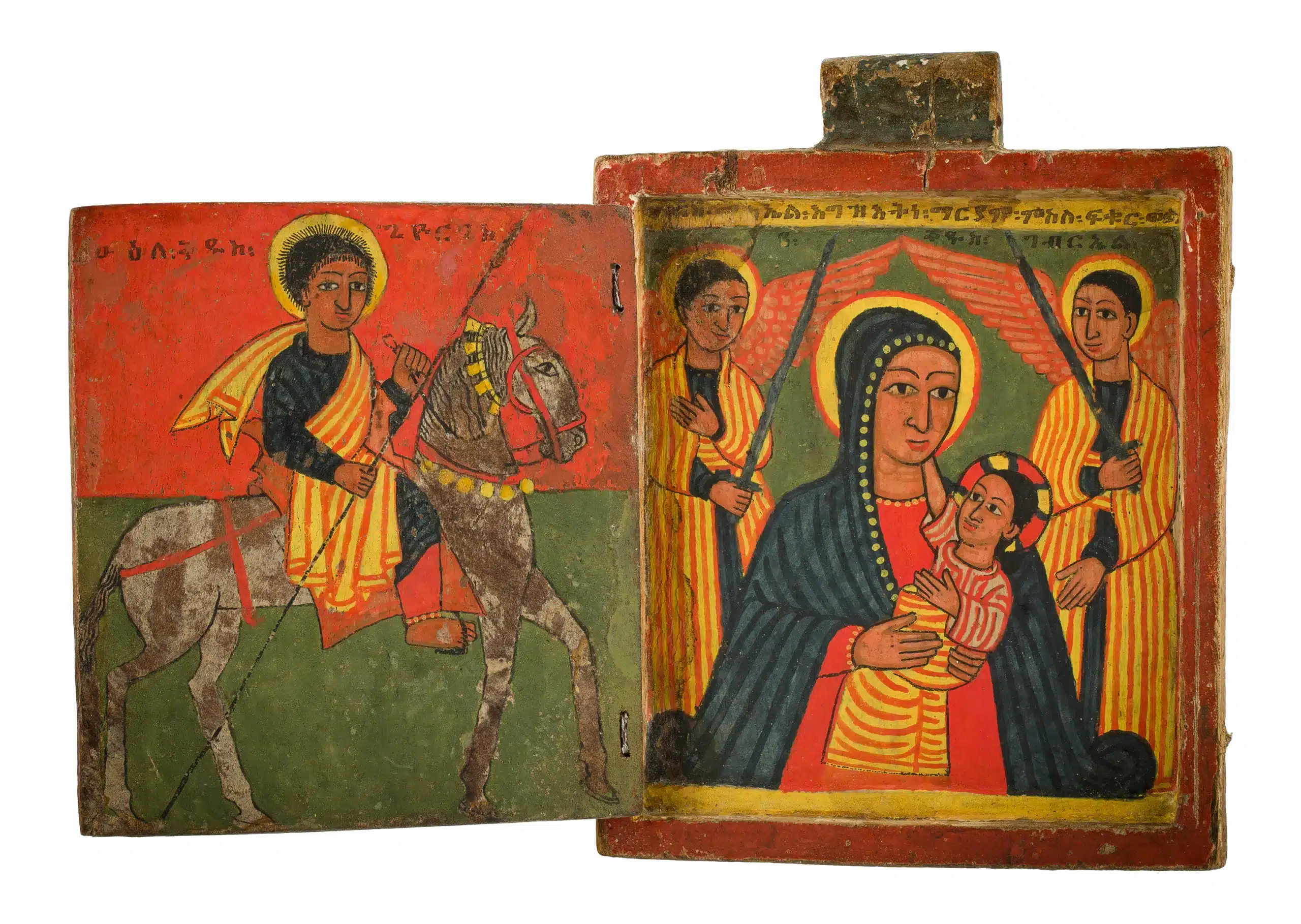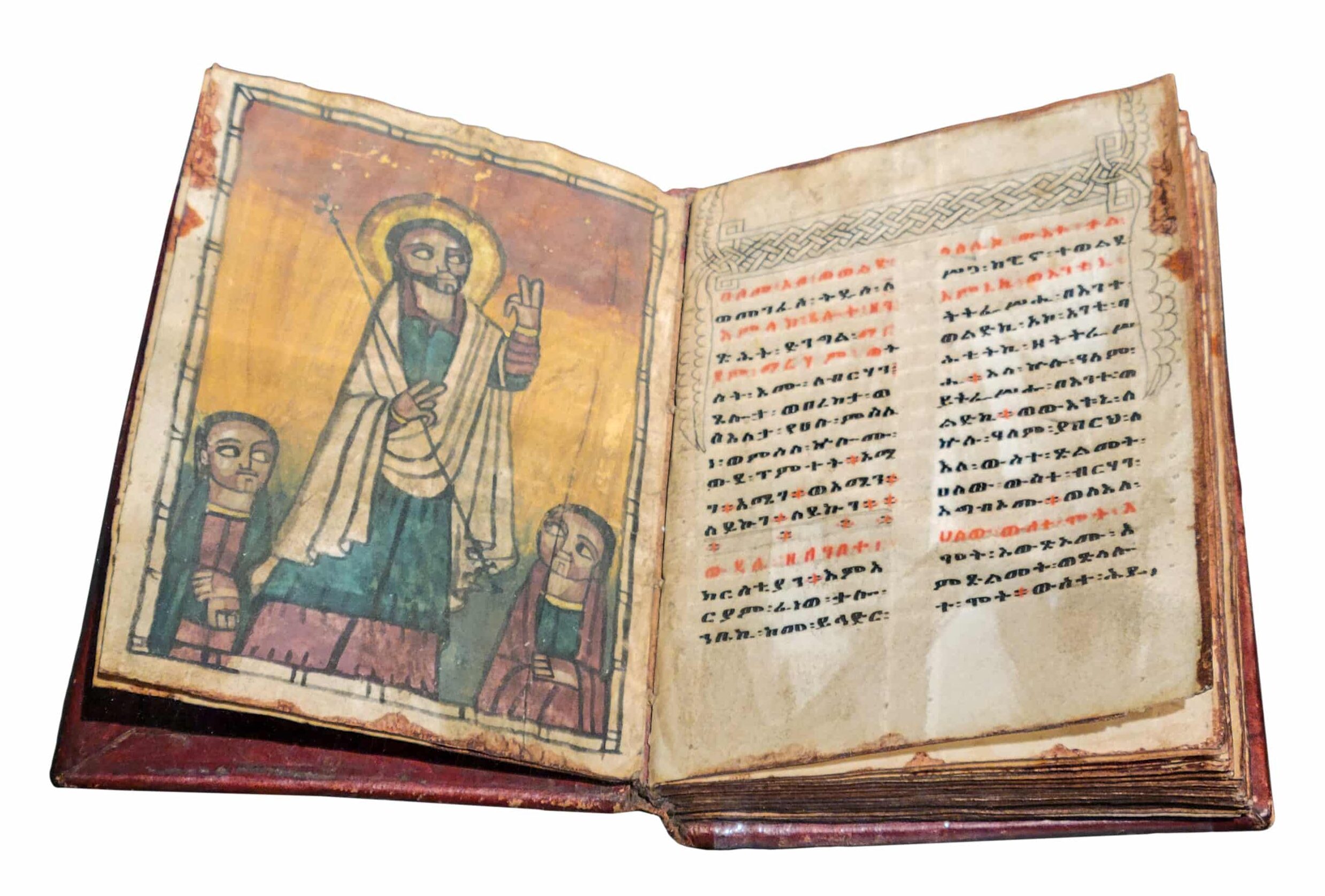Current Exhibitions
Skin, Script, Spirit: Ethiopia
May 16, 2024—December 1, 2024
Skin, Script, Spirit: Ethiopia
May 16, 2024—December 1, 2024
Curated by Justin Willson and Simon Morsink
Skin, Script, Spirit: Ethiopia will be the first research installation at The Icon Museum and Study Center, highlighting three intriguing objects that are recent gifts and acquisitions.
The lands of Ethiopia have an ancient and storied history that can be traced back as far as 3000 BCE. Christianity found an early home in Ethiopia, officially adopted under King Ezana in the second half of the 4th century, making it one of the world’s oldest Christian cultures. This rich heritage is reflected in the fascinating and unique icons and liturgical objects produced in the region.



The large goatskin, the centerpiece of this installation, may have been painted for a church or home. Its original function remains unclear. Hung by a rod through the top seam, the skin later received a leather loop and a bottom strip, allowing it to be rolled up and secured.

Mary with Selected Saints
Late 19th or 20th Century
Paint on goatskin
Ethiopia
91.44 x 66.04 cm
The upper half of this goatskin is a copy of a fifteenth-century triptych at the Institute of Ethiopian Studies Museum at Addis Ababa. Painted in the Moon-like Faces style, it shows Mary flanked by Gabriel and Michael, and Peter and Paul. While the painter includes the detail of Christ holding the dove, he omits the customary sprig held by Mary. The figure of the Ancient of Days dominates the upper right section, while rows of apostles, prophets, and angels populate the other registers. The painter has added a lower row of founders and a central figure of a turbaned man who, besides the Ancient of Days, is the only individual to stare out at the viewer. The text in the lower half opens with the first words of the Gospel of John and continues with a prayer. The repetitions in the text may suggest the goatskin functioned as an amuletic device.
The prayerbook on parchment is written in Ge’ez, the liturgical language of Ethiopia. Parchment manuscripts continued to be produced in Ethiopia through modern times.
Illuminated Prayer Book
19th Century
Ink and paint on parchment
Ethiopia
18 x 25.5 cm
This prayer book contains a Marian cycle with six miniatures from the lives of Mary and Christ: the Annunciation; Christ giving the Keys to Peter; the Crucifixion; the Resurrection; Mary holding the Christ Child; and an unidentified scene from Mary’s life. Expressively painted, the Crucifixion focuses on the oversized figures of Mary and John the Evangelist, whereas Christ’s body is greatly diminished. Gazing with horror at her son who has just exhaled his last breath, Mary weeps, covering her mouth with her hands. John lifts his arm, as if to shield his view from the tragic sight of his teacher. The painter has added yellow highlights to the borders of Mary’s veil and Christ’s loincloth, accentuating the garments of the holiest figures. Falling stars, a detail typical of Ethiopian crucifixion iconography, rain down from the heavens.
Gift of Ikonengalerie Mönius, 2014


The double-sided pendant diptych, depicting the Ethiopian emperor Basil (Fasilides), offers a window into the veneration of leaders and saints in the Ethiopian Orthodox Church.


Two-Sided Pendant Diptych with Feasts and Saints
Late 17th or Early 18th Century
Tempera on wood
Ethiopia
24.2 x 117.2 cm
The front left wing of this pendant diptych shows Saint Basil (Fasilides in Ge’ez), emperor of Ethiopia from 1632 to 1667, riding on horseback as a warrior saint. The inscription below states that this “picture” belongs to Walda Krestos. The upper right wing shows the Resurrection with Christ liberating Adam and Eve from Hades, and the Crucifixion with Mary and John. Below are three Ethiopian saints: Abba Takla Haymanot, Abba Ewostatewos, and Abuna Gabra Manfas Qeddus, who are accompanied by the priest Abba Kiros. This combination of figures is found on older diptychs from the Gondarine School, which flourished in Gondar, the capital founded by Emperor Fasilides, in the late seventeenth and early eighteenth centuries. The warm reds and bold yellows are typical of Ethiopian panel painting and manuscript illumination. Krestos’s signature is found on other pendant diptychs from the mid- to late- seventeenth century. Worn around the neck, pendant diptychs were popular among nobility and the elites.
We invite you to join us in researching our Ethiopian collection. Share your thoughts and insights by clicking below to enter the discussion board.
The Icon Museum and Study Center is grateful to Meseret Oldjira, who shared her knowledge of these objects.